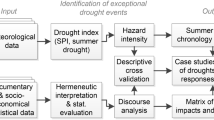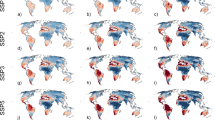Abstract
Regional newspaper coverage from 1998 to 2007 is examined to expand our understanding of the complexity of drought impacts and vulnerability in the Carolinas. Coverage at the height of two droughts reports drought effects extending beyond first-order impacts on broadly recognized sectors, such as agriculture, livestock, and water supplies to recreation and tourism and impacts on businesses, manufacturing, and households. Impacts were accompanied by social controversies with near-term and long-term planning and development implications. Key concepts in vulnerability analysis were used to structure the review of vulnerability reporting. The coverage of differential vulnerability, although limited, identified individual, household, local, and cross-scale factors that influenced the severity of impacts. Articles also highlighted additional interacting stresses in some sectors contributing to the severity of impacts experienced. An elaborated understanding of drought impacts and vulnerabilities is a necessary, early step in advancing efforts to developing a risk-based drought management approach.



Similar content being viewed by others
Notes
The author interviewed 10 water systems and community service agencies in western North Carolina about their experiences with failure of household wells and how individuals coped as part of a preliminary investigation for another project.
References
Adger WN (2006) Vulnerability. Glob Environ Change 16:268–281
AP, Associated Press (1998) Prepare for drought, forecasters warn. The Post and Courier, Charleston, SC
AP, Associated Press State & Local Wire (2005) No rain in N.C. means drought conditions spread, worsen, November 15, 2005 Tuesday
Baldwin A (2007) Lawn care industry thirsty for business: with fewer appointments, companies hiring fewer workers. The Charlotte Observer, Charlotte, NC, September 13, 2007 Thursday
Biesecker M (2002) Triad is wasting water, study says researchers find urban sprawl increasing effects of drought. Winston-Salem Journal, Winston Salem, NC, August 30, 2002 Friday
Binker M (2002) Landscapers complain rules wilt business. News & Record Greensboro, North Carolina, September 4, 2002 Wednesday
Carbone GJ, Rhee J, Mizzell H et al (2008) A regional-scale drought monitor for the Carolinas. Bull Am Meteorol Soc 88(12):20–28
Chambers R (1989) Vulnerability, coping and policy. IDS Bull 20(2):1–7
Changnon SA, Easterling WE (1989) Measuring drought impacts—the Illinois case. Water Resour Bull 25(1):27–42
Clary E (2002) With land dry, some Charlotte, N.C.-area businesses blossom. The Charlotte Observer, August 16, 2002 Friday
Collins J (2002) Drought causes upstate streams to disappear. The State, Columbia, SC, August 20, 2002 Tuesday
Collins TW, Bolin B (2007) Characterizing vulnerability to water scarcity: the case of a groundwater-dependent, rapidly urbanizing region. Environ Hazards 7:399–418
Cross JA (1994) Agroclimatic hazards and dairy farming in wisconsin. Geogr Rev 84(3):277–289
DeGaetano AT (1999) A temporal comparison of drought impacts and responses in the New York city metropolitan area. Clim Change 42(3):539–560
Dow K (1992) Exploring differences in our common future(s): the meaning of vulnerability to global environmental change. Geoforum 23:417–436
Eakin H, Luers AL (2006) Assessing the vulnerability of social-environmental systems. Ann Rev Environ Resour 31:365–394
Earl J, Martin A, McCarthy JD et al (2004) The use of newspaper data in the study of collective action. Ann Rev Soc 30:65–80
Eisley M, Bracken D (2007) Ban possible on new water tie-ins; Raleigh and Durham are weighing tougher water restrictions as supplies inch down. The News & Observer Raleigh, North Carolina, December 5, 2007 Wednesday
FEMA, Federal Emergency Management Agency (1995) National mitigation strategy: partnerships for building safer communities. Federal Emergency Management Agency, Washington, DC
Finan TJ, West CT, Austin D et al (2002) Processes of adaptation to climate vulnerability: a case study from the US Southwest. Clim Res 21:299–310
Fussel HM, Klein RJT (2006) Climate change vulnerability assessments: an evolution of conceptual thinking. Clim Change 75:301–329
Goldberg D (2007) Farmers worry over dry weather; gas prices, demand for ethanol affect corn prices negatively and positively. Chapel Hill Herald, Durham, NC, July 8, 2007
Hayes MJ, Svoboda MD, Knutson CL et al (2004) Estimating the economic impacts of drought. I 2004. American Meteorological Association
Hill TD, Polsky C (2007) Suburbanization and drought: a mixed methods vulnerability assessment in rainy. Mass Environ Hazards 7:291–301
Holleman J (2007) Drought level sinks to severe: declaration sends signal to state that water conservation is. The State, Columbia, SC, September 6, 2007 Thursday
IPCC, Working Group II (2007) Summary for policy makers. IPCC, Geneva
Karl TR, Melillo JM, Peterson TC (eds) (2009) Global climate change impacts in the United States. Cambridge University Press, Cambridge
Kasperson RE (1983) Acceptability of human risk. Environ Health Perspect 52:15–20
Kasperson RE, Dow K et al (2006) Vulnerable peoples and places. In: Hassan R, Scholes R, Ash N (eds) Millennium ecosystem assessment: conditions and trends. Island Press, Washington, DC, pp 143–164
Keenan SP, Krannich RS (1997) The social context of perceived drought vulnerability. Rural Soc 62(1):69–88
Knutson CL, Hayes MJ (2001) South Carolina drought mitigation and response assessment: 1998–2002 drought. Natural Hazards Research Center, Boulder, CO
Lott N, Ross T (2006) Tracking and evaluating US billion dollar weather disasters, 1980–2005. 86th AMS annual meeting, preprints CD [cited Sept. 20, 2009]. Available from http://www1.ncdc.noaa.gov/pub/data/papers/200686ams1.2nlfree.pdf
Martinez A (2003) Better season for farmers. The News & Observer, Raleigh, North Carolina, July 11, 2003 Friday
Mitchell H (2005) Hickory has more than enough water. The Charlotte Observer, Charlotte, NC, June 5, 2005 Sunday
Mitchell H (2007) Farmers suffering as crops wither: soybeans and apples are stunted; pastures and grain for cattle are dying. The Charlotte Observer, Charlotte, NC, August 19, 2007 Sunday
NCDC, National Climate Data Center (2008) National Climate Data Center
NDMC, National Drought Mitigation Center (2006) Understanding and defining drought. National Drought Mitigation Center 2006 [cited August 7 2009]. Available from http://drought.unl.edu/whatis/concept.htm
Neuendorf KA (2002) The content analysis guidebook. Sage, Thousand Oaks, CA
Norman D (2002) A livelihood threatened: cattlemen lose money as drought limits feed. Spartanburg Herald—Journal, Spartanburg, SC, August 28, 2002
Norris FH, Stevens SP, Pfefferbaum B et al (2008) Community resilience as a metaphor, theory, set of capacities, and strategy for disaster readiness. Am J Commun Psychol 41:127–150
Norwood A (2007) Cracked earth, foundations: drought conditions causing clay to give way, which can damage the homes above. The Charlotte Observer, Charlotte, North Carolina, October 25, 2007 Thursday
NSF ACERE, Advisory Committee for Environmental Research and Education (2009) Transitions and Tipping points in complex environmental systems. National Science Foundation, Washington, DC
Ortiz DG, Myers DJ, Walls NE et al (2005) Where do we stand with newspaper data? Mobilization 10:397–419
Price M (2007) Drilling to save lawns: residents pay to preserve landscaping but counties say groundwater supplies also suffering amid drought. The Charlotte Observer, Charlotte, North Carolina, October 11, 2007 Thursday
Price J, Hennessy-Fiske M (2002) Towns desperate for water. News and Observer, Raleigh, North Carolina, August 11, 2002 Sunday
Ramsey C (2003) Rain puts damper on South Carolina golf industry. The State, Columbia, SC, May 25, 2003
Rayner S, Cantor R (1987) How fair is safe enough—the cultural approach to societal technology choice. Risk Anal 7:3–9
Renn O (2004) Perception of risks. Toxicol Lett 149:405–413
Romoser J (2007) Weather, price weed out more western NC burley tobacco farmers. AP local and regional, November 26, 2007 Monday
Rose A (2007) Economic resilience to natural and man-made disasters: multidisciplinary origins and contextual dimensions. Environ Hazards 7:383–398
Schreiner M (2003) Chancellor’s documentary focuses on water shortage. Morning Star, Wilmington, NC, January 14, 2003 Tuesday
Sen A (1981) Poverty and famines: an essay on entitlement and deprivation. Clarendon Press, Oxford
Smit B, Wandel J (2006) Adaptation, adaptive capacity and vulnerability. Glob Environ Change Hum Policy Dimens 16:282–292
Steinnemann AC, Hayes MJ, Cavalcanti LFN (2005) Drought indicators and triggers. In: Wilhite DA (ed) Drought and water crises. Taylor & Francis, Boca Raton, pp 71–92
Swensen E (2005) Drying up. News & Record, Greensboro, NC, November 15, 2005 Tuesday
Tänzler D, Feil M, Kromker D et al (2008) The challenge of validating vulnerability estimates: the option of media content analysis for identifying drought-related crises. Reg Environ Change 8:187–195
Turner BL, Kasperson RE, Matson PA et al (2003) A framework for vulnerability analysis in sustainability science. Proc Natl Acad Sci USA 100(14):8074–8079
US Drought Monitor (2009) Drought monitor archives. National drought mitigation center 2009 [cited August 7, 2009]. Available from http://drought.unl.edu/dm/archive.html
US Supreme Court (2009) South Carolina, Plaintiff v. North Carolina [cited September 20, 2009]. Available from http://origin.www.supremecourtus.gov/docket/22o138.htm
USDA, US Dept. of Agriculture, Economic Research Service (2007a) North Carolina state fact sheet [cited September 20, 2009]. Available from http://www.ers.usda.gov/Statefacts/NC.htm
USDA, US Dept. of Agriculture, Economic Research Service (2007b) South Carolina State fact sheet [cited September 20, 2009]. Available from http://www.ers.usda.gov/Statefacts/SC.htm
Vásquez-León M, West CT, Finan TJ (2003) A comparative assessment of climate vulnerability: agriculture and ranching on both sides of the US-Mexico border. Glob Environ Change 13:159–173
Velliquette B (2002) Free water to pour for those whose wells run dry; donations to help low-income people hit hard by drought. Chapel Hill Herald, Chapel Hill, NC, September 14, 2002 Saturday
Wilhelmi OV, Wilhite DA (2002) Assessing vulnerability to agricultural drought: a Nebraska case study. Nat Hazards 25(1):37–58
Wilhite DA, Buchanan-Smith M (2005) Drought as hazard: understanding the natural and social context. In: Wilhite DA (ed) Drought and water crises. Taylor and Francis, Boca Raton, FL, pp 3–29
Wilhite DA, Pulwarty RS (2005) Drought and water crises: lessons learned and the road ahead. In: Wilhite DA (ed) Drought and water crises. CRC Press, Boca Raton, FL, pp 389–398
Wilhite DA, Hayes MJ et al (2000) Planning for drought: moving from crisis to risk management. J Am Water Resour As 36(4):697–710
Wilhite DA, Svoboda MD, Hayes MJ (2007) Understanding the complex impacts of drought: a key to enhancing drought mitigation and preparedness. Water Resour Manage 21(5):763–774
Williams B (2001) Drought grips western half of state. News and Observer, March 17, 2001 Saturday
Wisner B, Blaikie P, Cannon T, Davis I (2004) At risk: natural Hazards, people’s vulnerability and disasters. Routledge, London
Withers L (2002) Woes impact wallets; residents’ attitudes about the years-long drought vary depending on whether rain helps or hurts their businesses. News & Record, Greensboro, NC, June 3, 2002 Monday
Zhang Y, Lindell MK, Prater CS (2009) Vulnerability of community businesses to environmental disasters. Disasters 33:38–57
Acknowledgments
I would like to thank the reviewers for their helpful suggestions and my colleagues Greg Carbone, Kirsten Lackstrom, and Sara Yorty for the discussions that helped me integrate these issues. The work is supported by a grant from NOAA’s Climate Program Office, Regional Integrated Sciences and Assessments Program Award number NA06OAR4310007.
Author information
Authors and Affiliations
Corresponding author
Rights and permissions
About this article
Cite this article
Dow, K. News coverage of drought impacts and vulnerability in the US Carolinas, 1998–2007. Nat Hazards 54, 497–518 (2010). https://doi.org/10.1007/s11069-009-9482-0
Received:
Accepted:
Published:
Issue Date:
DOI: https://doi.org/10.1007/s11069-009-9482-0




